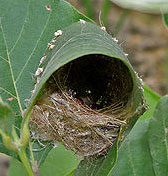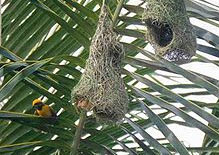How do tailorbirds sew their nests? Tailorbirds which are found across tropical Asia use their beaks like a sewing needle. Their strings are silk they obtain from spider net, cotton from seeds or fibers they pluck from barks. In building their nests, they first select developing leaves on a tree and put these leaves into shape by dragging them upon one another. Then the bird pierces every leaves’ edge with its sharp pointed beak. Then he sews the leaves together with his beak with plant fiber, spider’s web and knots every loop to make it tight. When the same operation is done for the other leaf, the leaves are sewn together. Almost half a dozen looms are required to attach a pair of leaves or a single leaf. Then the bird mats this sac with grass and decorates it. Besides he spins also another secret nest into which it can lay the female’s eggs.
Tailorbirds which are found across tropical Asia use their beaks like a sewing needle. Their strings are silk they obtain from spider net, cotton from seeds or fibers they pluck from barks. In building their nests, they first select developing leaves on a tree and put these leaves into shape by dragging them upon one another. Then the bird pierces every leaves’ edge with its sharp pointed beak. Then he sews the leaves together with his beak with plant fiber, spider’s web and knots every loop to make it tight. When the same operation is done for the other leaf, the leaves are sewn together. Almost half a dozen looms are required to attach a pair of leaves or a single leaf. Then the bird mats this sac with grass and decorates it. Besides he spins also another secret nest into which it can lay the female’s eggs.
The Ploceidae, or weavers, weaving their nests with great resolution, patience and skill The weaver bird first collects the materials it will use. It cuts thin and long strings from fresh and green leaves or takes their middle veins. There is one reason why they especially choose fresh leaves. It is very difficult for to control the materials it obtains from dry leaves and to use them in weaving. These operations can only be easily done by the materials obtained from fresh leaves. The bird starts the operation first by wrapping the edge of a fiber it plucks from a leaf around a forked branch. While it holds the edge of fiber upon the branch with one foot, it administers the other edge with its beak. In order to prevent the fibers from falling it attaches them to one another by knotting them together. It first forms a circle; this is the entrance of the nest. Then it uses its beak like a weaver’s shuttle, weaving leaf fibers under and over other fibers one by one.
The weaver bird first collects the materials it will use. It cuts thin and long strings from fresh and green leaves or takes their middle veins. There is one reason why they especially choose fresh leaves. It is very difficult for to control the materials it obtains from dry leaves and to use them in weaving. These operations can only be easily done by the materials obtained from fresh leaves. The bird starts the operation first by wrapping the edge of a fiber it plucks from a leaf around a forked branch. While it holds the edge of fiber upon the branch with one foot, it administers the other edge with its beak. In order to prevent the fibers from falling it attaches them to one another by knotting them together. It first forms a circle; this is the entrance of the nest. Then it uses its beak like a weaver’s shuttle, weaving leaf fibers under and over other fibers one by one.  During this operation of weaving the bird should also be able to calculate how tightly each fiber should be drawn because if the weavings not tight enough the nest immediately collapses. This aside, it should be able to imagine the final state of the nest so that it can decide when to give curves to the walls or make protrusions upon it.
During this operation of weaving the bird should also be able to calculate how tightly each fiber should be drawn because if the weavings not tight enough the nest immediately collapses. This aside, it should be able to imagine the final state of the nest so that it can decide when to give curves to the walls or make protrusions upon it.
Once the entrance is weaved, it proceeds with the walls of the nest. For this purpose it hangs upside down and continues to work from inside. With its beak it places one fiber under the other and then it delicately holds the end that remains outside and draws it tightly. At the end the bird forms an extremely regular weaving on the walls of the nest.
It is Allah, the Lord of all beings on Earth, Who inspires the weaver bird to weave its nest as a result of all these complicated operations. All Mighty Allah relates this fact in the Qur’an as follows:
 “Do you not see that everyone in the heavens and earth glorifies Allah, as do the birds with their outspread wings? Each one knows its prayer and glorification. Allah knows what they do.“ (Nur Suresi, 41)
“Do you not see that everyone in the heavens and earth glorifies Allah, as do the birds with their outspread wings? Each one knows its prayer and glorification. Allah knows what they do.“ (Nur Suresi, 41)


